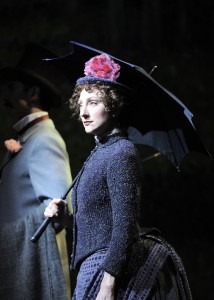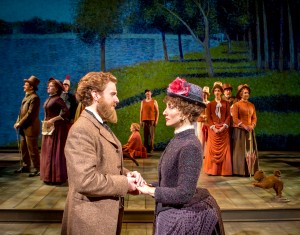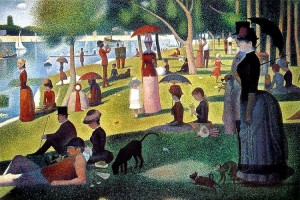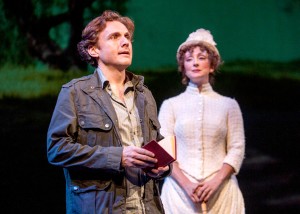A TRIUMPHANT MASTERPIECE
 Rare is the theatrical experience that is so haunting and so achingly beautiful that your soul actually feels caressed and nurtured. The transcendent production at hand is Chicago Shakespeare’s revival of Sondheim and Lapine’s 1984 Pulitzer Prize-winning musical Sunday in the Park with George. The musical fable is based on the short life of pointillist painter Georges Seurat and his magnum opus A Sunday Afternoon on the Island of La Grande Jatte; the flawless self-contained first act is the imagined creation of the monumental 1884 work (which resides nearby at the Art Institute of Chicago), and the somewhat unwieldy second act concerns the painter’s great-grandson almost a century later. There are many astounding attributes in this production, but its greatest achievement is that Act II no longer feels like the bastard child of Act I. With an assured hand, director Gary Griffin centers on the humanity of the characters, guiding his cast into a realm of authenticity rarely seen in any musical; this genuineness only serves to highlight the universal truths in Sondheim’s lyrics. As such, the show grabs a hold of the audience’s communal heart and quietly pulls it forward toward the show’s magnificent perspectives on life and art, turning this into a five-hanky affair. This truly is the theatrical event of this or any other season.
Rare is the theatrical experience that is so haunting and so achingly beautiful that your soul actually feels caressed and nurtured. The transcendent production at hand is Chicago Shakespeare’s revival of Sondheim and Lapine’s 1984 Pulitzer Prize-winning musical Sunday in the Park with George. The musical fable is based on the short life of pointillist painter Georges Seurat and his magnum opus A Sunday Afternoon on the Island of La Grande Jatte; the flawless self-contained first act is the imagined creation of the monumental 1884 work (which resides nearby at the Art Institute of Chicago), and the somewhat unwieldy second act concerns the painter’s great-grandson almost a century later. There are many astounding attributes in this production, but its greatest achievement is that Act II no longer feels like the bastard child of Act I. With an assured hand, director Gary Griffin centers on the humanity of the characters, guiding his cast into a realm of authenticity rarely seen in any musical; this genuineness only serves to highlight the universal truths in Sondheim’s lyrics. As such, the show grabs a hold of the audience’s communal heart and quietly pulls it forward toward the show’s magnificent perspectives on life and art, turning this into a five-hanky affair. This truly is the theatrical event of this or any other season.
Seurat is a man who keeps his life under control via sketch pad and canvas; whether furiously sketching the island’s varied denizens, or tapping away on the giant canvas in his studio, his obsessive desire to complete his work (a fanatisicm he refers to as “Finishing the Hat”) only serves to keep him disconnected from other, more meaningful relationships, especially with both his lover and his mother. Jason Danieley wisely eschews the histrionics that some actors have brought to the role of George; he internalizes the struggle between creating art and living his life, presenting an array of emotions which has us simultaneously pity Seurat’s disconnectedness and support his work. Even Mr. Danieley’s singing voice is a palette of colors, from a tremulous or quavering vibrato to a glassy sostenuto.
Carmen Cusack, who waxed enchanting in the South Pacific National Tour, offers a revelational rendering as the lover Dot; imbued with a matronly spirituality, Ms. Cusack also internalizes the vulnerability and frustration of a woman in love who knows that her relationship is on the skids, but must move on. At times, she reminded me of the wistful ballerina in Toulouse-Lautrec’s Seated Dancer, so vivid were the impressionistic brushstrokes of sadness and hope on her face. Cusack’s glorious rendition of “We Do Not Belong Together” validates that this is the most elegantly painful break-up song in Broadway history.
Also surprising was the emotional capper of the evening, “Move On,” a simple reminder to any audience member who forgets that it’s not so much that you do what you like as it is that you like what you do. The voices of Danieley and Cusack blend so well that Sondheim’s eternal and universal messages fill us with hope’”you may just want to be a better person yourself after seeing Sunday.
The original production, directed by librettist James Lapine, had overt mugging in it, which could be funny at the moment, but somehow diminished the humanity of the characters. Griffin has no such thing in his production: The French characters in Act I and their modern counterparts at a contemporary museum in Act II are never the caricatures seen in past productions.
There is also a richer relationship between Georges and his mother, making this Sunday more about family than an artist’s personal journey’”and also validates a profundity hitherto unseen. Linda Stephens certainly portrays the mother as a fussbudget, but there is a sad yearning for something she cannot have that rounds out the role; later in Act II, Stephens has the juiciest moments as Art Critic Blair Daniels, who challenges Seurat’s great-grandson George to move on from his series of electronic sculptures known as Chromolumes.
 Such a uniformly stupendous cast deserves mentioning by name: Rachel Cantor, McKinley Carter, Sean Fortunato, Kevin Gudahl, Derek Hasenstab, Ora Jones, Heidi Kettenring, Elizabeth Lanza, Michael Aaron Lindner, Benjamin Magnuson, Madison Olszewski, and Travis Taylor. The guidance of music director Brad Haak made the challenging score seem like a walk in the park, and I kindly plea for an original cast recording.
Such a uniformly stupendous cast deserves mentioning by name: Rachel Cantor, McKinley Carter, Sean Fortunato, Kevin Gudahl, Derek Hasenstab, Ora Jones, Heidi Kettenring, Elizabeth Lanza, Michael Aaron Lindner, Benjamin Magnuson, Madison Olszewski, and Travis Taylor. The guidance of music director Brad Haak made the challenging score seem like a walk in the park, and I kindly plea for an original cast recording.
The orchestra sat perched high above the stage; conducted by Ryan T. Nelson, the clarity of Michael Starobin’s orchestrations is what one would expect at the finest concert halls. As with the actors, each individual voice’”the harp, the piccolo’”could be distinctly heard, yet’”as with the colors of a pointillist painting’”they blended into seamless perfection of bold new colors arranged by the ear. A special acknowledgement to Nelson’s nimble work on the piano and celeste, Maria Honigschnabel’s dexterity with that tricky Sondheim phrasing on the synthesizer, and Sharon Jones’ silky sound on the French horn.
Creating costumes based on a painting is not easy work, but Mara Blumenfeld brings them to vivid life; the dappled lighting of Philip S. Rosenberg is its own triumphant work of art, and the sound design by Dan Mead and Ray Nardelli is (and I’m not kidding) the best balance of performer and musician and sound effects that I remember in the theater’”it was as if I had headphones on. But what is remembered most is the spectacular projection design by Mike Tutaj: The back wall is used as a sketch pad, with images either in sharp focus or blurring like a water color caught in the rain; even leaves on the island’s trees shimmer and sway’”you can almost feel a breeze on your face.
Griffin blocks the event as an artist paints on a canvas’”not an inch of space is wasted on the proscenium thrust stage. We always know who to focus on, and each moment rings with truth. Ultimately, for this critic who has been so bedraggled by mediocrity, this is Griffin’s coup de théâtre; all it takes is one transformative night in the theater to make me believe in art, family, creativity, invention, and moving on.
George’s 98-year-old great-grandmother Marie (also played by Ms. Cusack with a believable combination of strength and palsy), looks at a girl in Seurat’s mainly misunderstood (at the time) masterpiece, and notes, “See how she shimmers? I mean, from the heart.” That also perfectly describes this revival. My only regret is that Chicago Shakespeare’s production cannot permanently reside at the Art Institute next to the painting which inspired it.
photos by Liz Lauren
Sunday in the Park With George
Chicago Shakespeare
Courtyard Theater on Navy Pier
ends on November 4, 2012
for tickets, call 312.595.5600 or visit Chicago Shakes
for more theater, visit Theatre in Chicago





{ 1 comment… read it below or add one }
There is nothing as lovely as someone who loves the theatre attending a show that is transcendent. Nice review!